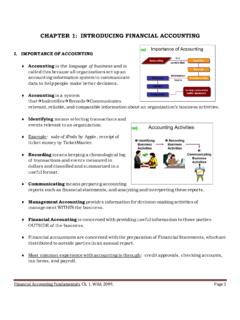Transcription of CHAPTER 3: PREPARING FINANCIAL STATEMENTS
1 FINANCIAL Accounting Fundamentals, Ch. 3, Wild, 2009. Page 1 CHAPTER 3: PREPARING FINANCIAL STATEMENTS I. TIMING AND REPORTING A. The Accounting Period Time period assumption an organization s activities can be divided into specific time periods. Examples: a month, a three-month quarter, a six-month interval, or a year Accounting (Reporting) periods length of time covered by FINANCIAL STATEMENTS . Most companies use a year as their primary accounting period. Annual FINANCIAL STATEMENTS reports covering a one-year period. Interim FINANCIAL STATEMENTS covering one, three, or six months of activity. Many companies prepare interim FINANCIAL STATEMENTS . Calendar year January to December. Fiscal year consisting of any 12 consecutive months.
2 Example: Gap s fiscal year starts in February of one year and goes till the end of January the next year. Natural business year businesses will end their year at their lowest level of the year. When FINANCIAL STATEMENTS are prepared, to keep STATEMENTS accurate within this time period assumption, certain adjustments need to be made to the STATEMENTS . FINANCIAL Accounting Fundamentals, Ch. 3, Wild, 2009. Page 2 EXAMPLE: You are the owner of a heavy construction company that does major, long-term projects. You sign a contract to build the new school indoor pool facility. The cost of the building is $1,000,000 and it is built over 2 years (2010 and 2011). You receive $900,000 of the proceeds in 2011 when the building is done, but on fiscal year December 31, 2010 you prepare your 2010 FINANCIAL STATEMENTS to renew your insurance with the bonding company.
3 So, how much revenue would you report in 2010? If you only reported the $100,000 ($1,000,000-900,000) in 2010 you most likely would be GROSSLY UNDERSTATING your revenue for the year. When we divide business activities into arbitrary fixed periods of time, it is often necessary to have special accounting for transactions that cross from one time period to the next. B. Accrual verses Cash Basis 1. Accrual Basis Accounting It uses the adjusting process to recognize revenues when earned and expenses when incurred (matched with revenues). It s a system of accounting in which revenues and expenses are recognized when they are earned and incurred as opposed to when cash is actually received or paid. It better reflects business performance.
4 It also increases the comparability of FINANCIAL STATEMENTS from one period to another. 2. Cash Basis Accounting Recognizes revenues when cash is received and records expenses when cash is paid. Up until now, we have focused on cash basis accounting, which is used for some small businesses where the difference would be immaterial for tax purposes, but is not GAAP. FINANCIAL Accounting Fundamentals, Ch. 3, Wild, 2009. Page 3 Cash basis is not consistent with GAAP. Is useful for several business decisions which is the reason companies must report a Statement of Cash Flows. 2. Accrual VS Cash Example Accrual Example: FastForward paid $2,400 for 24 months of insurance coverage beginning on December 1, 2009. Accrual requires that $100 of insurance expense be reported on December s Income Statement.
5 Another $1,200 of expense is reported in year 2010. The remaining $1,100 is reported as expense in the first 11 months of 2011. The accrual basis Balance Sheet reports any unexpired premium as a Prepaid Insurance asset. Accrual Accounting for Allocating Prepaid Insurance to Expense Cash Basis Example: A cash basis Income Statement for December 2009 reports Insurance Expense of $2,400. The Income STATEMENTS for years 2010 and 2011 report NO Insurance Expense. The cash basis Balance Sheet NEVER reports an insurance asset because it is IMMEDIATELY expensed. The cash basis income for 2009-2011 FAILS to match the cost of insurance with the insurance benefits received for those years and months. Cash Accounting for Allocating Prepaid Insurance to Expense FINANCIAL Accounting Fundamentals, Ch.
6 3, Wild, 2009. Page 4 C. Recognizing Revenues and Expenses With ACCRUAL BASIS, we recognize REVENUE when the product or service is delivered to our customer. Under the ACCRUAL BASIS, EXPENSES are recognized in the same period as the affiliated sale. The adjusting process helps us match the expenses incurred to generate the revenue recorded from the sales transaction. We rely on two principles in the adjusting process : Revenue Recognition and Matching. 1. Revenue Recognition Principle Requires that revenue be recorded WHEN EARNED, not before and not after. The goal is to have the revenue reported in the time period when it is earned. Revenue is recognized on the books of a company when two criteria are met: 1) The earnings process is substantially complete.
7 2) Cash has either been collected or the collectability is reasonably assured. 2. Matching Principle Aims to record expenses in the same accounting period as the revenues that are earned as a result of those expenses. Matching expenses with revenues often requires us to predict certain events. When we use FINANCIAL STATEMENTS , we must understand that they require estimates and therefore include measures that are not precise. FINANCIAL Accounting Fundamentals, Ch. 3, Wild, 2009. Page 5 The concept that ALL costs and expenses that are incurred to generate revenues must be recognized in the same period as the revenues. II. ADJUSTING ACCOUNTS Adjusting Entry is recorded to bring an asset or liability account balance to its proper amount; it also updates a related expense or revenue account.
8 1. Framework for Adjustments Adjustments are necessary for transactions and events that extend over more than one period. At the end of the accounting period, which is generally the end of the fiscal year, to comply with GAAP and accrual accounting companies make adjusting journal entries in order to reconcile income and expense recognition WHEN EARNED AND INCURRED according to GAAP, not necessarily when cash is received or paid. All adjusting entries ultimately fall into one of 4 different categories as shown on the above graphic. There are two broad categories of adjustments: 1) When we pay or receive cash BEFORE the expense or revenue is recognized. This category includes prepaid or deferred expenses (including depreciation), and unearned or deferred revenues.
9 2) When cash is paid or received AFTER the expense or revenue is recognized. These are some very common adjustments. The category includes accrued expenses and accrued revenues. 2. Prepaid (Deferred) Expenses Are items paid for in advance of receiving their benefits. You pay for something before it provides you a benefit. Prepaid expenses are assets. When these assets are used, their cost becomes expenses. FINANCIAL Accounting Fundamentals, Ch. 3, Wild, 2009. Page 6 A prepaid account is an asset, because when one pays an expense, you are giving something up that you own, so when making an adjusting entry to recognize a prepaid expense you are just reclassifying cash (an asset) that is paid out to another type of asset (prepaid).
10 You still own the cash even though the vendor has it, because the service that justifies the expense has not been performed yet. Adjusting for Prepaid Expenses 1. Prepaid Insurance {Adjustment (a)} EXAMPLE: On December 1, we have to make a journal entry to recognize the cash paid out. Since we still OWN the cash, our total assets should not drop. We need to reclassify the cash paid to a Prepaid Expense as follows: December 1 Prepaid Insurance 12,000 Cash 12,000 Paid a 6 month insurance policy in advance. **This is the INITIAL ENTRY when you paid for the insurance in the adjustment. At the end of the year (Dec. 31), 1 of the 6 months of the insurance policy has been used. Therefore the insurance company has earned 2/6 of the policy premium, or $2,000.










